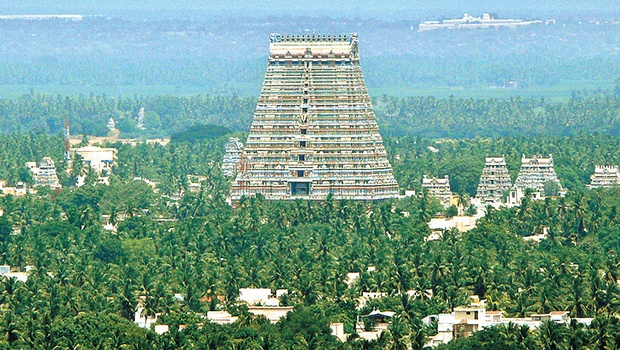#ashokasays Did you know 301:
Cauvery River enroute from
Talakaveri,Bhagamandala in Karnataka to the place where it meets the sea
in Poompuhar,Tamil Nadu has innumerable number of temples on its banks.
The three prominent Vishnu temples on the banks which has been there
from ages are Aadi Ranga (Sri Ranganatha Swamy at Srirangapatana),
Madhya Ranga (Sri Jaganmohana Swamy at Shivanasamudra) and Anthya Ranga
(Sri Aranganathar at Srirangam at Thrichy)
Each
of these temples have rich history behind their existence. Sriranga at
Thrichy in Tamil Nadu is what I would look at today.
Located on an Island on Cauvery river, the temple is constructed in the Dravidian style of architecture, and It is one of the most illustrious Vaishnava temples in South India rich in legend and history.
The temple has been constructed/renovated over a long period of time across dynasties. The main entrance, the Rajagopuram, rises from the base area of around 13 cents (around 5720 sq ft) and goes up to 237 feet (72 m), moving up in eleven progressively smaller tiers.
A well-planned temple town with continuous human activity. An outstanding architectural wonder with a wide range of sculptures, ornate pillars, artistically made huge stone images. The temple complex is a master piece of human creation and ingenuity. The scale and size of the complex is quite unprecedented and mind-boggling, making it the largest functioning temple complex in the world. The temple occupies an area of 156 acres (631,000 m²) with a perimeter of 4,116m (10,710 feet) making it the largest temple in India and one of the largest religious complexes in the world.The temple is enclosed by 7 concentric walls (termed prakarams (outer courtyard) or mathil suvar) with a total length of 32,592 feet or over six miles.
These temple has 21 gopurams (towers), 39 pavilions, 50 shrines, Ayiram kaal mandapam (a hall of 1000 pillars) and several small water bodies inside. The Hall of 1000 pillars (actually 953) is a fine example of a planned theatre-like structure and opposite to it, “Sesha Mandap”, with its intricacy in sculpture, is a delight.The 1000-pillared hall made of granite was constructed in the Vijayanagara period (1336–1565) on the site of the old temple.
Located on an Island on Cauvery river, the temple is constructed in the Dravidian style of architecture, and It is one of the most illustrious Vaishnava temples in South India rich in legend and history.
The temple has been constructed/renovated over a long period of time across dynasties. The main entrance, the Rajagopuram, rises from the base area of around 13 cents (around 5720 sq ft) and goes up to 237 feet (72 m), moving up in eleven progressively smaller tiers.
A well-planned temple town with continuous human activity. An outstanding architectural wonder with a wide range of sculptures, ornate pillars, artistically made huge stone images. The temple complex is a master piece of human creation and ingenuity. The scale and size of the complex is quite unprecedented and mind-boggling, making it the largest functioning temple complex in the world. The temple occupies an area of 156 acres (631,000 m²) with a perimeter of 4,116m (10,710 feet) making it the largest temple in India and one of the largest religious complexes in the world.The temple is enclosed by 7 concentric walls (termed prakarams (outer courtyard) or mathil suvar) with a total length of 32,592 feet or over six miles.
These temple has 21 gopurams (towers), 39 pavilions, 50 shrines, Ayiram kaal mandapam (a hall of 1000 pillars) and several small water bodies inside. The Hall of 1000 pillars (actually 953) is a fine example of a planned theatre-like structure and opposite to it, “Sesha Mandap”, with its intricacy in sculpture, is a delight.The 1000-pillared hall made of granite was constructed in the Vijayanagara period (1336–1565) on the site of the old temple.
The history of this temple dates back to the days of Rama. Sriranga Mahathmiyam
is the compilation of religious accounts of the temple which detail the
origins of its greatness. According to it, Lord Rama, himself an Avatar
of Vishnu, worshiped the idol for a long time, and when he returned
victoriously from Sri Lanka after destroying Ravana, he gave it to King
Vibhishana, brother of Ravana as a token of appreciation.
About temple antiquity, evidences prove the origin of the temple is in 1st century CE during the Sangam period (3rd Century BCE )This temple was built by several dynasties Cholas of Thanjavur, the Kongu rulers from Tamil west, the Pandyas from south (6th – 10th Centuries CE and 13th – 14th Centuries CE), the Hoysalas (10th – 14th Centuries CE), and the later rulers and viceroys of the celebrated Vijayanagara Empire of Karnataka (16th Century CE.)
About temple antiquity, evidences prove the origin of the temple is in 1st century CE during the Sangam period (3rd Century BCE )This temple was built by several dynasties Cholas of Thanjavur, the Kongu rulers from Tamil west, the Pandyas from south (6th – 10th Centuries CE and 13th – 14th Centuries CE), the Hoysalas (10th – 14th Centuries CE), and the later rulers and viceroys of the celebrated Vijayanagara Empire of Karnataka (16th Century CE.)
INCREDIBLE BHARATHA









No comments:
Post a Comment